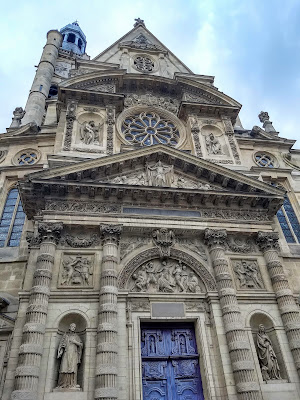A novel that I recently read (Goodbye Paris, by Mike Bond) claims that the Champ de Mars is overrun by prostitutes and drug dealers at night, and that the police won't go there then. That is absolutely NOT TRUE.
 |
| Peace pavilion and Eiffel Tower. |
Mike Bond also writes that Clotilde was Charlemagne's wife. Not true. Clotilde was the wife of Clovis I, the first king of the Franks. Charlemagne had four or so wives, and none of them were named Clotilde. Clotilde had been dead for nearly two centuries before Charlemagne was born!
 |
| The daily specials menu at Le Petit Tonneau. |
I read the book anyway because so many of the scenes take places in parts of Paris that I know so well and that I love -- for example, the Place du Commerce, the Champ de Mars, and Avenue Emile Zola. But no, I do not recommend the book. Artistic license is one thing, but his book is just plain wrong, in a number of ways.
Last night, we walked up the Avenue de la Motte Picquet, past the Champ de Mars, and on up to the Seine along the Avenue de la Tour Maubourg. There we decided that it was time to find dinner. I searched the Lafourchette.com ratings on restaurants near that end of the Avenue, and came up with Au Petit Tonneau on the Rue Surcouf -- about 2 and a half miles from our apartment.
 |
| Chateubriand and Lyonnaise potatoes at Le Petit Tonneau. |
Petit is accurate. This tiny bistro with red and white checkered tablecloths seemed to be so familiar to us; I'm sure we dined there years ago. We should not have forgotten it!
Somehow the patron squeezed us in even though it was nearly 8PM and we did not have a reservation (we both apologized for that).
Tom ordered the Chateaubriand steak with Lyonnaise potatoes, and I ordered the classic sole meuniere. I allowed the patron to de-bone the sole for me, even though I usually prefer to do it myself. He was so good and efficient at the deboning; I'm glad I made that choice.
 |
| La Sole Meunière et pommes de terre Grenaille au Petit Tonneau. |
The sole with brown butter and lemon, and little roasted potatoes were all wonderful; so were Tom's Chateaubriand and Lyonnaise potatoes.
For dessert, Tom had the classic tarte tatin, and I had the lemon meringue pie.
After we ordered dessert, the older French lady sitting next to me said, "Do you know about tarte tatin? It is a mistake." I smiled and replied, "Yes, it is upside down!" She exclaimed, "That's right! You know it!"
Here's the story, in case you're interested.
 |
| La tarte Tatin et la tarte au citron au Petit Tonneau. |
A petit tonneau is a small barrel. The restaurant of this name has been in place in the 7th arrondissement for over 80 years. In April of this year, during the 7th's first annual Festival of Bistrots, the mayor of the 7th arrondissement, Rachida Dati, sent a letter to congratulate the owner of Le Petit Tonneau for winning third place in the festival's competition.
The owner of Le Petit Tonneau is Madame Arlette Bou Chalhoub, according to Mayor Dati's congratulatory letter. The great chef is Vincent Neveu. Last night, I had difficulty in deciding between the sole meunière and the blanquette de veau. Today, I read that Chef Neveu's blanquette de veau is among the very best in all of Paris. So, we must go back there soon.
After dinner, we strolled toward home. As we approached the Peace Pavilion end of the Champ de Mars, we noted that the tower would start twinkling in a few minutes. So we sat upon a park bench and waited. The show was lovely, as always.






















































